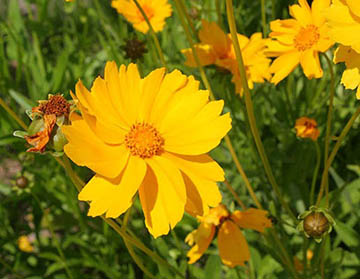Lance-leaf coreopsis (Coreopsis lanceolata) is native to most of the continental U.S. It is one of eight species of coreopsis native to Kentucky and is the species that is the most common. Other names for lance-leaf coreopsis include tickseed and sand coreopsis. The name tickseed comes from the fact that its dark brown seeds resemble ticks. The name sand coreopsis comes from the fact that it likes to grow in sandier, well drained areas rather than areas with heavy, wet clay.

This native, perennial wildflower grows naturally in open areas like prairies and barrens. It is also commonly planted as an ornamental and incorporated in wildflower seed mixes. Lance-leaf coreopsis grows in clumps and will spread some from self-seeding. Older plants can be divided and new plants can be grown from the seeds. It is a very drought tolerant plant and overwatering can cause more issues than forgetting to water it.
In the late spring, usually April and May in Kentucky, lance-leaf coreopsis will send up a series of shoots that produce bright yellow flower heads. The flowers can be enjoyed in the garden / field or cut and brought inside for flower arrangements. While late spring is its primary bloom time, lance-leaf coreopsis will produce occasional blooms for a much longer period of time. Also in a garden setting, the primary bloom time can be extended if the flowers are deadheaded before they have a chance to go to seed.
Many different species of native bees and butterflies will visit lance-leaf coreopsis. In some areas, honey bees will also use it depending on what else is blooming at the same time. It is also a host plant for the caterpillars of several moth species which will eat the foliage or flower heads. If the flowers are allowed to go to seed, many different songbirds will devour the seeds.
If you are looking for an easy-to-grow, spring-blooming wildflower to incorporate into your landscape, lance-leaf coreopsis is one you might want to consider. Because it has become such a popular garden plant, it can sometimes be found in traditional nurseries and big box stores. It is also one of the many Kentucky wildflowers that I grow in my nursery.

This article was part of Shannon’s original Kentucky Pollinators and Backyard Wildlife blog which evolved into the blog for Backyard Ecology.

Backyard Ecology: Exploring Nature in Your Backyard
Nature isn’t just “out there.” It’s all around us, including right outside our doors. Hi, my name is Shannon Trimboli, and I am the host of Backyard Ecology. I live in southcentral Kentucky and am a wildlife biologist, educator, author, beekeeper, and owner of a nursery specializing in plants for pollinators and wildlife conservation. I invite you to join me as we ignite our curiosity and natural wonder, explore our yards and communities, and improve our local pollinator and wildlife habitat. Learn more or subscribe to my email list at www.backyardecology.net.

Leave a Reply